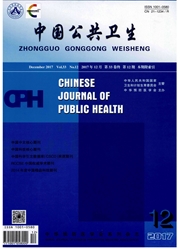

 中文摘要:
中文摘要:
目的探讨干旱地区影响呼吸道传染病流行的关键气象因子,建立干旱地区呼吸道传染病的反馈(BP)神经网络预测模型,为政府部门预防和控制干旱地区的呼吸道传染病提供科学依据。方法选择辽宁省朝阳市作为研究对象;在朝阳市气象局获得该地区1981~1994年气象资料;在朝阳市疾病预防控制中心获得同期该市传染病发病资料。应用SPSS 10.0统计软件进行气象因素与传染病发病率的相关关系分析。应用Matlab6.5软件构建BP人工神经网络模型,建立干旱地区呼吸道传染病的BP人工神经网络预测模型,并对模型进行评价。结果相关分析结果显示,流行性脑膜炎的发病率与平均气压、平均降水量呈负相关,与平均蒸发量呈正相关;百日咳的发病率与平均气压呈负相关,与平均蒸发量呈正相关。BP神经网络模型拟合结果显示,流脑和百日咳模型拟合值的平均误差率(MER)和决定系数(R0)分别为1.73%和1.0000,7.74%和0.9900;流脑模型拟合效果最好;流脑和百日咳BP神经网络模型的预测精度分别为5.88%和59.46%。结论平均气压、平均蒸发量、平均降水量对呼吸道传染病发病率影响较大。BP神经网络模型对干旱地区呼吸道传染病具有较高的拟合和预测能力,预测效果较好。
 英文摘要:
英文摘要:
Objective To investigate the relationship between meteorological factors of drought and incidence of common infectious diseases. The Back - Propagation artificial neural network model was built and evaluated. Methods The data of incidence of infectious diseases and meteorological factors in drought area from 1981 to 1994 were collected and analyzed by using SPSS for windows, version 10.0 ; The model of back - Propagation artificial neural network was built by Matlab, version 6.5. Results The incidences of epidemic was negative correlated to annual mean atmospheric pressure, annual mean precipitation, and was positive correlated to annual mean evaporation. The incidence of pertussis was negative correlated to annual mean atmospheric pressure and positive correlated to annual mean evaporation. The MER and R 2 of cerebrospinal meningitis and pertussis model were 1.73 % and 1, 7.74 % and 0. 990 0 respectively. The forecasting precision of cerebrospinal meningitis and pertussis model was 5.88 % and 59.46 % respectively. Conclusion The incidence of aspiratory infectious diseases was correlated to atmospheric pressure, precipitation, and evaporation. The BP neural network model fitted very well in the study of aspiratory infectious diseases.
 同期刊论文项目
同期刊论文项目
 同项目期刊论文
同项目期刊论文
 期刊信息
期刊信息
